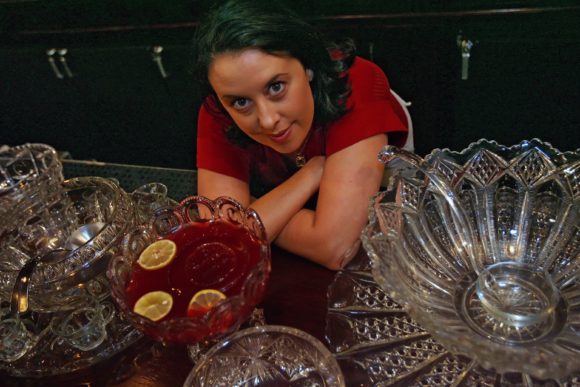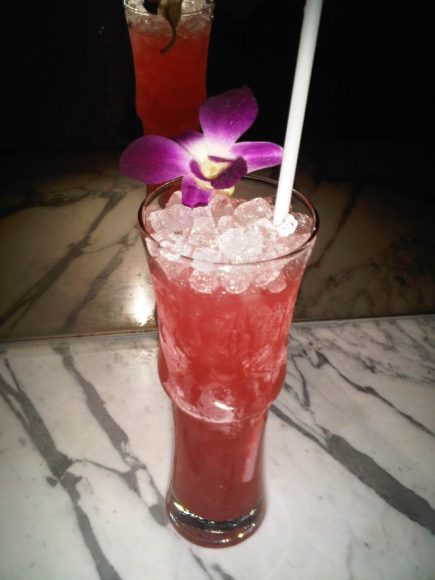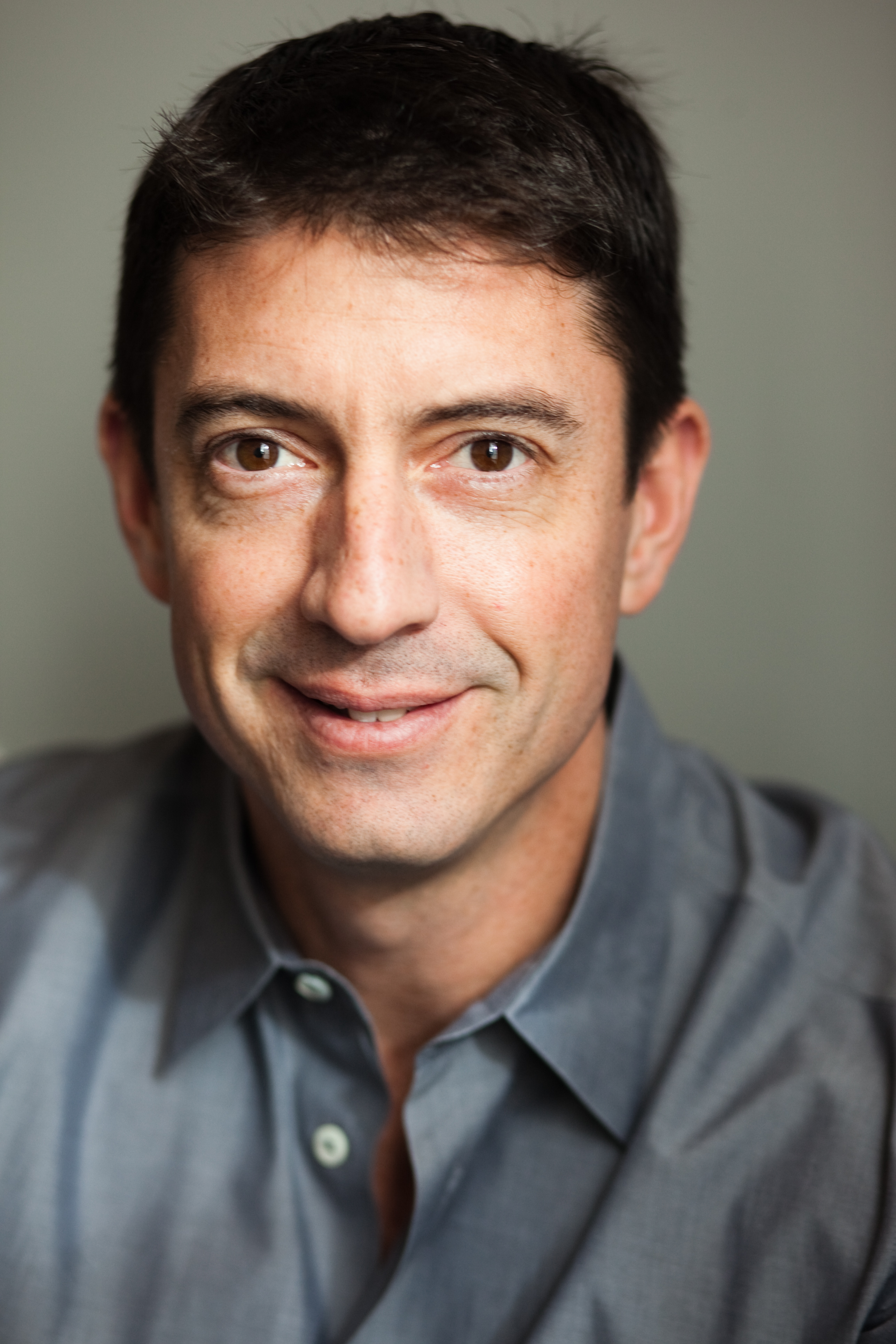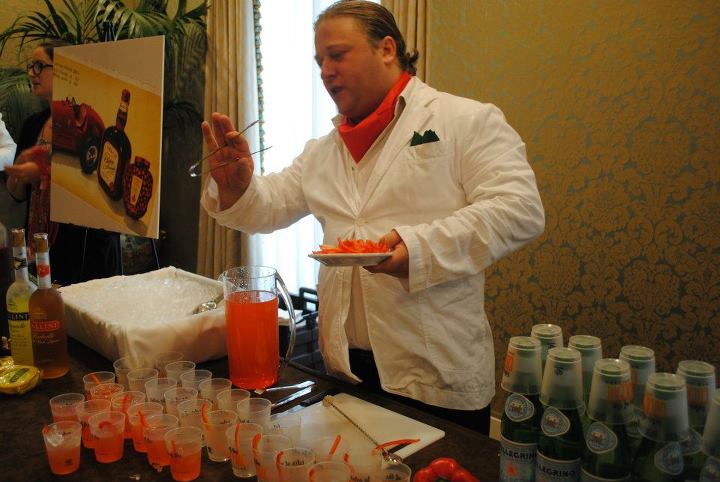Julie Reiner
By David Ransom
Julie Reiner’s favorite spirit is not what you probably think it is. As she’s a native of Hawaii, one would think that Julie’s dream drink would include exotic ingredients like pineapple, star fruit, and rum, and inspire visions of far off places like the north shore of Kauai or the white sand beaches of Fiji. However, while she does show a deft hand at creating masterful libations reminiscent of Gauguin’s South Pacific, her personal go-to drink is far more mainland than that. But rather than let the cat out of the bag in my own words, I think it may be best to let Julie tell us in hers…later.
As one of the world’s most accomplished and respected mixologists, Julie has helped define an industry, and along the way, built herself a mini empire of trendsetting cocktail bars that have been emulated countless times around the world. Strange as it may seem, while growing up the last thing Julie ever thought was that she’d end up in the business she’s in, or that she’d play such a major role in pioneering what we now call the world’s “cocktail culture.” Yet that’s what she’s done, and it may have been inadvertently due to the fact that she gets bored easily.
Spend some time with her, and one almost immediately notices that Julie has a somewhat restless spirit, visibly apparent in her mannerisms and constant need to out-do her last success and not rest on her laurels. So, it may not be such a stretch to say that boredom played a key role in making her who she is today, as lack of inspiration invariably leads one to want to change a situation to the way they feel it should be. And this is certainly true in Julie.
Like many young people first starting out in the job world, she was first drawn to the hospitality industry for the benefits it offered; like flexible hours, excitement, and quick money. Her first job, as a cocktail waitress at the Hotrod Café on Honolulu’s famed Waikiki Beach, was the perfect vehicle for this, and she did well there, but never dreamed of actually pursuing it as a career path. However, life has a strange way of dictating to us what we are born to do; and we are powerless to change it, no matter how hard we try. Calvin called it predestination, Aristotle and Taylor called it fatalism, and luckily for us, Julie’s experience at Hotrod Café lit an internal spark that remained burning no matter how hard she tried to extinguish it. And it kept coming back to life until she finally gave in and let it blaze the path to her future.
After the Hotrod Café, college was in her immediate future and, having spent her formative years on Oahu, and feeling there was lots more world to see, she decided to go to school as far from Hawaii as she could, attending Florida State University in Tallahassee and majoring in communications. “While I did not pursue communications as a career, I find it very useful now that I own my own businesses, Julie says, “as it gave me an inside track to understanding how to promote myself and my brands. It’s almost like I’m the client AND publicist all wrapped up into one person.” Talking with Julie these days, one can see that she chose well, as she seems to innately be able to calculate the most “news-worthy” response to a question with almost political-like speed, and is a master at dealing with not only media relations, but her clients, as well (the day of our interview at Clover Club, she was hosting billionaire Nets owner Mikhail Prokhorov in the back room while he gave press interviews about moving the team to Brooklyn).
Armed with her degree, and wanting a change of scenery, Julie moved to San Francisco to work for her aunt in an “office environment.” While she loved where she lived, she quickly tired of working at a desk, and started looking for work in the hospitality world again. “I was very bored,” she says, “and addicted to hospitality. So I started looking around for other jobs to fill my free time.” Not necessarily wanting to work the floor, she searched for bartending jobs, and soon found work at San Francisco’s Red Room, and then Asia SF. ”Asia was a drag queen bar and restaurant,” Julie recalls fondly, “I loved that place. As the only ‘true-gender employee’, my nickname was ‘Mama’.”
Mama couldn’t stay with her chickadees forever and, in 1996, once again feeling a need for a change, Julie decided to move to New York. Like many people who move to the big city to follow their dreams, she found it tough to find work at first. “It was quite hard to find a job, really,” Julie recalls, “There were very few women behind the bar in New York. It was a real dude fest.” She did eventually find work, however, tending bar at Studio 54, which had just been re-opened as a theatre again after it’s (in)famous run as a disco, and was hosting a sold-out run of the revival of Cabaret.
Fun as it was to work there, after its transition from world’s most (in)famous disco to Broadway theatre, Studio 54’s bar was basically run as a concession, and it afforded Julie no real opportunity to further her craft or work in a true bar atmosphere. So, she soon found herself searching elsewhere, eventually landing a job as bar manager at Washington Square’s C-III restaurant.
It was at C-III that Julie started to make real magic happen. Inspired by what she was seeing in the kitchen, and bored by what she was being given to work with behind the bar, Julie started applying similar techniques to the cocktails she was making; like using fresh juices instead of canned, and creating syrups and flavor components from scratch to create “interesting drinks” and seasonal cocktail menus for her clientele. “This was not de-rigueur in NYC at the time,” says Julie, “The only other place that was open then was probably Milk & Honey. We were really just making it all up as we went along, not knowing that there were others doing the same thing.”
This fresh approach soon caught the eyes of the media, like the New York Times, and Food & Wine Magazine, who started writing of the new cocktail revolution taking hold in the bars of downtown Manhattan. It also caught the attention of the few cocktail masters already practicing in New York, like the Rainbow Room’s Dale DeGroff, and Babbo’s Tony Abou-Ganim.
Dale, in particular, took a special interest in Julie’s work, and arranged for her to take part in a “celebrity bartender gig” he was hosting with another new talent on the scene, Audrey Saunders. This meeting led to a friendship between Julie and Audrey that would eventually become a business partnership, as well. But first, Julie needed a place of her own.
“I had this dream of a gourmet cocktail bar, with club-like atmosphere and over the top cocktails”, she says, “and as cocktail culture, while still in its infancy, was definitely starting to take off, I felt the time was right to make my dream a reality.” That dream, the now legendary Flatiron Lounge, which opened in 2003, was an instant success, and Julie, after years of hard work and careful planning, had finally gotten where she wanted to be.
Two years later, Flatiron rolling along, a new concept formed in her head, but feeling it may be too soon to put her name on a second marquee, Julie approached her friend Audrey to help her open her next venture, Pegu Club on Houston Street. “I had this great idea, but was a little apprehensive about putting my name out there yet, so close on the heels of opening Flatiron, so I approached Audrey to be the “face of Pegu”, while I ran the business side. She jumped at the concept, and the rest is history.” This latest endeavor, fueled by the success of Flatiron, was a huge hit, once again raising the bar on how cocktails, and cocktail establishments, were perceived, and it cemented Julie’s (and Audrey’s) star in the upper echelons of the cocktail elite.
With these two successful ventures now up and running in Manhattan, and seeing a growing number of upscale establishments opening over the bridge in Brooklyn, in 2008, Julie decided (much to the delight of that borough’s cocktail cognoscenti) to open her first solo venture, Clover Club, in Carroll Gardens. It opened to rave reviews. And, from there, there’s been no stopping her.
Her expertise and recipes have been in demand constantly, and she’s been featured on television shows like NBC’s The Today Show, and Food Network’s Iron Chef, and in countless magazines around the world. She also consults with restaurants and hotels, and regularly participates in industry events like Tales of the Cocktail and the Star Chefs International Chefs Congress, among many others.
These days, Julie, along with her partner Susan, is mama to 18-month old daughter Maya, and three of New York’s most successful Cocktail establishments. Her fourth, Lani Kai (meaning Heavenly Waters in Hawaiian), opens this month in Manhattan’s SOHO district, and will feature what Julie deems a modern tropical interpretation of her style, with Pacific Rim cocktails and cuisine.
I recently caught up with Julie over a cocktail at Clover Club, and got a chance to ask her a few questions:
DR: With all the “owner” obligations you have with your multiple establishments, not to mention your consulting and appearance schedule, do you ever find yourself behind the bar anymore?
JR: On occasion, when it’s busy.
DR: White spirits or brown?
JR: Definitely brown! I’m a bourbon girl to my core. I’ll also do a good aged rum on occasion.
DR: Cubed ice or crushed?
JR: Both! As a bartender, how can I pick!?!? You can’t make me choose one…
DR: Do you have a favorite ingredient you like to use in your recipes?
JR: I love using tea in a cocktail. It’s unusual, challenging, and very versatile. It also gives flavors you just can’t duplicate using other things.
DR: Do you have a favorite type of glassware?
JR: Oh please no, I’m always asked that…next?
DR: What do you see developing as a trend with your current clientele?
JR: Stronger, boozier drinks, of which I am not a fan. Drinks need balance.
DR: Where was your last big learning experience?
JR. My amazing staff teaches me new things on a daily basis. I couldn’t do it all without their talent and ingenuity.
DR: You’ve been at the forefront of this industry for a long time. That said, do you have any colleagues you consider to be mentors?
JR: I’m largely self taught. However, Dale Degroff had a BIG influence on me, or as I like to say when he’s within earshot, “…and Dale taught me how to cut garnishes…”
DR: Too funny. Speaking of garnishes, do you have any favorites?
JR: Probably pineapple leaves. But there are many. (Laughs) The Flatiron staff used to call my Summer Drinks menu the “Julie Reiner Garnish Challenge”. What can I say…
DR: What is your favorite spirit to drink neat or on the rocks?
JR: Bourbon. No, let me clarify that: Good bourbon!
DR: Do you have a home still, for experimental purposes, of course?
JR: No
DR: What cocktail have you had recently that blew you away, whose was it, and why was it special?
JR: Phil Ward’s Smoked Palomino at Mayahuel in NYC’s East Village. Simply delicious! He’s elevated the awareness of tequila and mezcal to a whole new level.
DR: Should rappers have spirits?
JR: NO! Because for them, it’s all about the marketing and package, and what’s inside the bottle is secondary. That bothers me.
DR: Do you feel that cocktails go well with food, and how do you feel about cocktail dinners?
JR: Certain types of food work, others don’t. I’m not a big fan of pairing. I feel that cocktails have a place in the meal at the beginning and end. Leave the middle for other things.
DR: Agreed. Do you like wine?
JR: LOVE Wine!
DR: Beer?
JR Not a big beer drinker, but if necessary, the Hitichino beers are really very good.
DR: Where do you see cocktail culture going in the next five years?
JR: Definitely forward. Once you have a well-crafted cocktail, it’s hard to settle for anything less, and the public is demanding quality. So, the trend will continue to grow.
DR: Describe what you think makes a perfect cocktail?
JR: Balance. It’s that simple. No one ingredient overpowering another.
DR: That said, do you limit ingredients in your recipes?
JR: No, but it can be tricky to use a lot. I don’t think limiting a recipe to a certain number of ingredients is necessary, as long as there is balance. However, we keep going back to the classics for inspiration because they work. And most of the classics were quite simple and had 3-4 ingredients.
DR: As a business owner, how do you find time to create new cocktails?
JR: I make “lab time” for myself behind the bar when the business is closed and nobody’s around. If I did it when the staff was here, they’d always have their straw in my drinks, checking and offering advice…which I hate!
DR: I can see how that would get to you. Do you ever take your work home with you?
JR: Always
DR: one last question… Whiskey or bourbon?
JR: Really? You just want to hear me say the word bourbon again, don’t you…
And there you have it. Julie Reiner, a native of Oahu, is a bourbon girl. ‘Nuff said.
PACIFIC SWIZZLE
2 oz tropical tea-infused Flor de Cana 4yr (this is an herbal tea with hibiscus, lemongrass, rose hip)
¾ oz simple syrup
½ oz lime juice
¼ oz passion fruit puree
Tea Infusion – Tazo Passion
4 tea bags per 1 liter bottle of rum
Let it steep for 30 minutes
Build in Collins glass; add crushed ice; swizzle.
Add more crushed ice; swizzle again.
Top w/ crushed ice.
Garnish: edible flower





Very good interview, I admire Julie and what she has accomplished.
Great article – – makes a looked forward to glass of wine, at the end of the day, sound a little boring .
Experimentation must come !
She is an inspiration and someone we all admire! And rightly so.
what an interesting,delightful person – our kind of gal! does she have a purple drink for The Purp;e Lady?
Glad you liked the Rocks Stars column on Julie. If you haven’t yet been to her new spot on Broome Street, Lani Kai, you should go. And eat something too! The food is as good as the cocktails.
If there’s not already something on her menu I’m sure Julie and her cracker jack staff could whip up something appealing.
Definitely experiment! But goodness knows a great glass of wine is always a great day’s end treat too.
Stefano,
Thanks for taking the time to comment and I’m glad you were pleased with David’s interview.
Julie is definitely someone I respect for her business acumen and we were thrilled to have her as a subject for our Rocks Stars column.